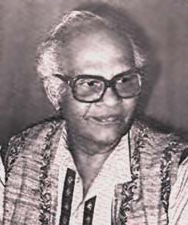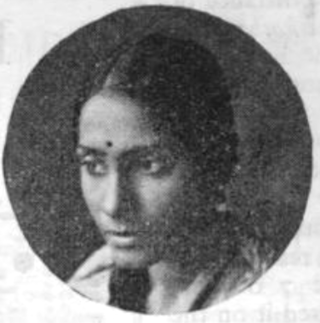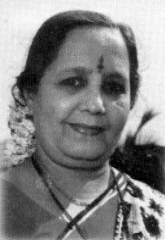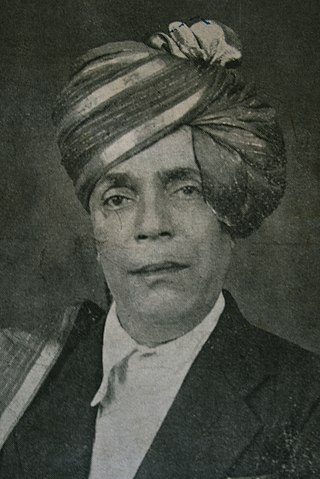Hindustani classical music is the classical music of the Indian subcontinent's northern regions. It may also be called North Indian classical music or, in Hindustani, shastriya sangeet. The term shastriya sangeet literally means classical music, and is also used to refer to Indian classical music in general. It is played on instruments like the veena, sitar and sarod. Its origins from the 12th century CE, when it diverged from Carnatic music, the classical tradition in South India. While Carnatic music largely uses compositions written in Kannada, Telugu, Tamil, Malayalam and sometimes in Sanskrit, Hindustani music largely uses compositions written in Urdu, Punjabi, Rajasthani and sometimes in Hindi.

Ramachandra Kundgolkar Saunshi, popularly known as Sawai Gandharva and Ram-bhau, was a popular Hindustani Classical vocalist from Karnataka. He was a master in the genre of Kirana Gharana style. He was the first and foremost disciple of Ustad Abdul Karim Khan, and guru of Bharat Ratna laureate Pandit Bhimsen Joshi.

Ustad Abdul Karim Khan was an Indian classical singer and, along with his cousin Abdul Wahid Khan, the founder of the Kairana gharana of classical music.

Prabha Atre was an Indian classical vocalist from the Kirana gharana. She was awarded all three of the Padma Awards by the Government of India. She died after experiencing breathing difficulty in the early hours and was taken to Dinanath Mangeshkar Hospital. She died from cardiac arrest before reaching the hospital. Atre died on 13 January 2024, at the age of 91.

The Mewati gharana is a musical apprenticeship tribe of Hindustani classical music. Known for being Pandit Jasraj's musical lineage, the gharana was founded by brothers Utd. Ghagge Nazir Khan and Utd. Wahid Khan (beenkar) of Indore in the late 19th century at the Holkar Court. Members of this gharana have had an active influence in Indian cinema for over half a century.

Pandit Taranath Ram Rao Hattiangadi was a performer and teacher of Indian classical percussion, known for his knowledge of rare talas and old compositions. He represented the Farukhabad, Delhi, and Ajrada gharanas of tabla, and the Nana Panse tradition of pakhavaj. He studied formally for 47 years—an exceptional amount of time, even in the Indian master-disciple system—under many pandits and ustads, most notably Shamsuddin Khan. He had numerous disciples and students of special training.

Kundgol also spelled as Kundagola is a panchayat town in Dharwad district in the Indian state of Karnataka.

Pandit Basavraj Rajguru was a leading Indian classical vocalist in the Kirana gharana.
The Gwalior Gharana is one of the oldest Khyal Gharana in Indian classical music. The rise of the Gwalior Gharana started with the reign of the Mughal emperor Akbar (1542–1605).
Ustad Abdul Wahid Khan (1871–1949) was an Indian subcontinental singer from the Kirana gharana. He died in 1949 in Saharanpur, India.

Hirābai Barodekar was an Indian Hindustāni classical music singer, of Kirana gharana. She was disciple of Ustād Abdul Wahid Khān.
Sureshbabu Mane was a prominent Hindustani classical music singer of Kirānā Gharānā in India. He was the son of a doyen of Kirana Gharana, Ustad Abdul Karim Khan.
Indore gharana is one of the vocal gharanas of Indian classical music. It was founded by Amir Khan, who studied the styles of Abdul Wahid Khan, Aman Ali Khan, Rajab Ali Khan and Abdul Karim Khan and amalgamated their style.

Saraswati Rane was an Indian classical singer in the Hindustani Classical genre. She was a daughter of Ustad Abdul Karim Khan (1872–1937), the founder of Kirana Gharana. Her family had a long and great music tradition. She got her initial training of vocal music of the Kirana Gharana style from her elder brother Sureshbabu Mane and elder sister Hirabai Barodekar, who themselves were the doyen of Indian classical music of their times. Later she also sang along with elder sister, Hirabai Bododekar, especially in jugalbandi style.

Manik Varma was an Indian classical singer from the Kirana and Agra gharanas.

Vishwanath Jadhav (1885−1964) was an Indian classical khyal singer and a disciple of Abdul Karim Khan, the founder of Kirana gharana.
Professor B. R. Deodhar was an Indian classical singer, musicologist and music educator. He was a vocalist of Khayal-genre of Hindustani classical music.

Vidushi Sumitra Guha is an Indian classical vocalist, known for her expertise in the Carnatic and Hindustani schools of classical music. The Government of India honored her in 2010, with the fourth highest civilian award of Padma Shri.
Abdul Latif Khan was an Indian classical musician and instrumentalist, known for his proficiency in Sarangi, a stringed Hindustani classical music instrument.
Arshad Ali Khan is an Indian classical singer belonging to the Kirana gharana.











